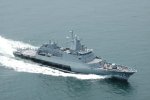Money and other resources.Why not arm those ships to the fullest potential from their very inception?? Why wait for a threat to come knocking at the doors before we decide to upgrade?? I'll never get this reactionary mindset.
Look at the latest german navy frigate : Baden-Württemberg-class frigate - Wikipedia





